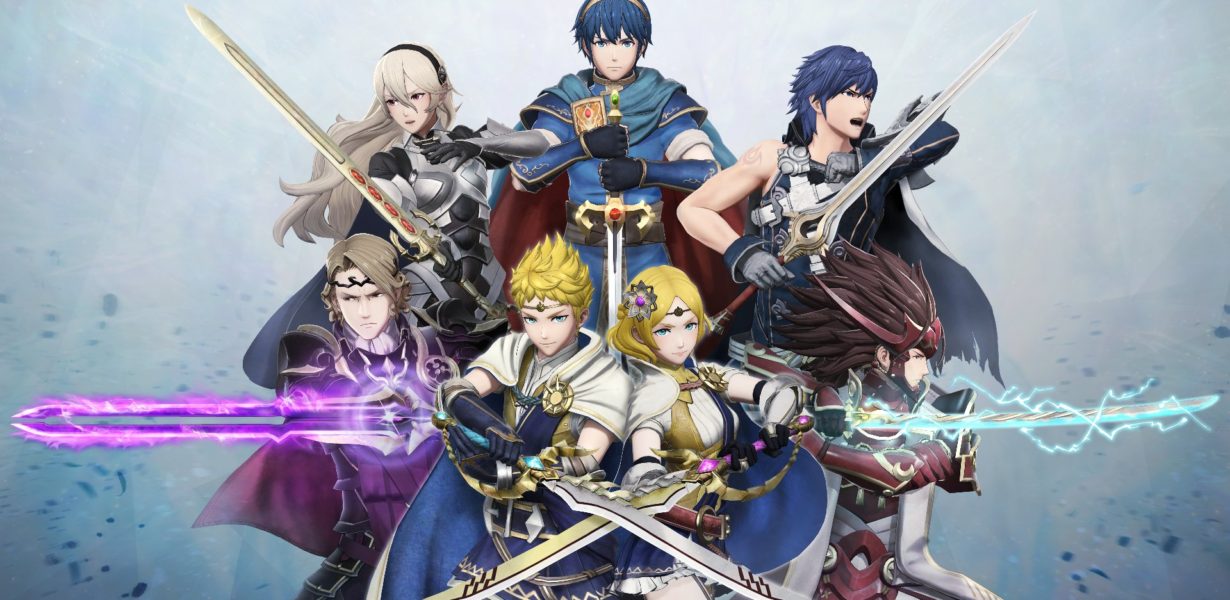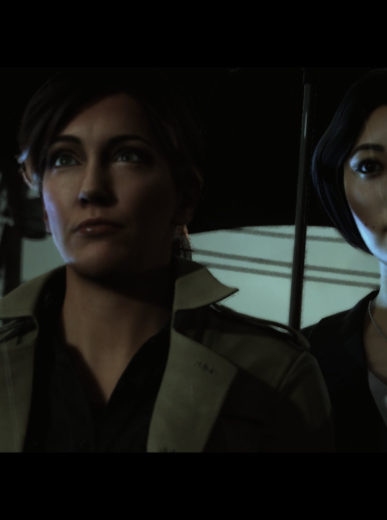The marriage between the tactical and methodical nature of the Fire Emblem series and Koei Tecmo’s more frantic hack-and-slash Warriors game seems like an odd one at first glance. But while Fire Emblem Warriors lacks the heart and charm that make the main series so appealing, it’s difficult to deny that this might very well be the most polished Warriors game we’ve seen in quite a long time, and if you can ignore a few of its glaring flaws, there’s a pretty fun action game to be enjoyed here.
As far as Warriors crossover games go, Fire Emblem Warriors’ story is as thin as they come. Siblings Rowan and Lianna are set up as the dual protagonists of this new story, and the world they live in is one day invaded by monsters from the Outrealm. After a tragic turn of events, Rowan and Lianna quickly link up with a few familiar faces from Fire Emblem Awakening as they decide to find more heroes and work together to expel their world of evil. The story is fairly straightforward, and there honestly isn’t that much to say about the main campaign aside from the fact that Rowan and Lianna are some of the most uninteresting and dull protagonists to have ever graced a video game. They’re so one-dimensional and unlikable, and are almost on par with Reynn and Lann from last year’s World of Final Fantasy.
Thankfully, though, you don’t have to play as them if you don’t want to. The game ends if either of them dies in a battle, and while they will be forced into certain missions, you still have a whole roster of other characters to choose from. Just like a regular Warriors game, Fire Emblem Warriors splits up its chapters into different missions where you’ll take your characters into a battlefield, take over forts, complete optional missions, and then complete your main objective – it usually involves killing thousands of soldiers, and then killing a big boss. Every mission lets you bring in four support characters that you can’t control, along with four main characters that are available for swapping at any time.
Gameplay-wise, combat is a process of hitting the X and Y buttons to execute heavy and light attacks, and chaining hundreds of regular mobs together to lock them in devastating combos. However, unlike your regular Warriors game, Koei Tecmo and Omega Force have also opted to incorporate a few Fire Emblem quirks into the game as well. For instance, unit pairing allows you to get two characters to link up, and they’ll be able to support each other in combat. Consequently, fighting together also lets them strengthen their bonds and relationships. That said, you’ll only unlock one support conversation once you’ve reached the maximum support level for those characters.
Strengthening relationships is important, though, as you can earn unique materials that are used to upgrade your characters’ offensive and defensive capabilities. Fire Emblem Warriors also features a fairly robust weapon upgrade system where you’re able to absorb powerful traits and abilities from one weapon and transfer them to another. It’ll take you a fair bit of grinding to craft the perfect weapon, but it’s easy to get lost in the process once you really immerse yourself in it.
It’s also extremely satisfying being able to build your own dream team of Fire Emblem heroes. My main roster was pretty much just a purple-haired gang consisting of Marth, Lucina, Camilla, and Chrom the entire time. As you unlock more characters, you get more freedom in deciding who makes up the main party and who are the supports. And then your compulsion to level everyone up equally starts to kick in, and the next thing you know, you’ve fallen down a dangerous rabbit hole of wanting to min-max every single hero.
While we’re on the topic of incorporating Fire Emblem quirks into the game, it’s worth mentioning that a lot of these gameplay and leveling systems from the main series feel watered down here. The support conversations are nice, especially when you get to see characters from different universes interact with each other, but they lack the depth and engagement that made them so great in the main games. Similarly, there’s also a class promotion system that lets you power up your characters with a Master Seal. However, you can’t actually change classes; a promotion just turns a Lord class character into a Great Lord, complete with some big stat boosts, but that’s about it. Every character has a set weapon type that can’t be changed.
The weapon triangle from Awakening and Fates also finds its way into Fire Emblem Warriors, though you’re not going to feel any sort of significant impact while playing on the standard difficulty setting. Apart from archers being able to completely decimate my flying units in two shots, weapons like swords, axes, and lances don’t seem to have that much of an advantage when you match them up with the types they’re strongest against.
There’s also a permadeath system in place if you play on Classic mode, but even this feels tacked-on and weightless. Characters who fall in battle can’t be used in combat, but you can bring them back if you have the right materials. ‘Dead’ characters also continue to be a part of story cutscenes and conversations, which completely breaks any form of immersion you might have. Given how half-assed this permadeath mechanic feels in Warriors, I can’t help but wonder why the developers even bothered including it at all.
However, there are a few quirks that actually work quite well here, and they even help to enhance the complexity of Fire Emblem Warriors’ gameplay. There’s a tactical side to the combat, and players can order their units to move to various locations around the map with a quick press of a button. From the map menu, you can order a unit to take over a fortress on the other side of the map, have them protect a valuable target, or have them pair up with one another. With the ability to quickly swap between playable characters, this also means that you can always place characters at different corners of the map so you can get to an objective swiftly if the need arises. While this tactical feature didn’t feel all that prominent in the first couple of chapters, the game does a good job of emphasizing its importance as the story goes on.
In a particular mission where Ryoma and Xander, the crown princes of Hoshido and Nohr respectively, were dueling each other to the death, it was up to our heroes to try to balance out their forces to stop one from killing the other. This meant that I had to take over forts on both sides, and be careful that the power balance didn’t fall too far in favor of Hoshido or Nohr. With the mission throwing curveballs at you, like incoming reinforcements and mini-bosses, it became quite the stressful ordeal as I had to make sure I had units ready to protect forts, while also making my way to the main bases before things escalated with Ryoma and Xander. The whole mission was a flurry of opening and closing the map to frantically reassign units to various locations, while also trying to keep my characters alive while inching forward.
When I revisited that mission later on in co-op mode, the need to strategize from the map was lessened, but it certainly didn’t diminish the fun I had with it. Split-screen co-op lets you and another player take control of different characters, and you can essentially divide and conquer, with one player focusing on wearing down Hoshido, while the other focuses on Nohr.
Outside of the story campaign, there is also an unlockable History Mode that lets you relive iconic battles and moments from past games. These mostly just serve as an optional method for you to grind for more money and materials, but they’re also a welcome break from the story, and it’s a nice way to revisit past events. The History Mode levels consist of a variety of challenges, including a score attack mode where you simply have to defeat as many enemies as you can within a time limit. They also provide the opportunity to let you play around with various characters and get used to their play styles.
That said, the character roster does feel painfully limited in Fire Emblem Warriors, and if you were hoping for an epic crossover game that featured heroes from all over the esteemed series, you’re going to be disappointed. The bulk of the roster features faces primarily from Fates and Awakening, with only a small handful from Shadow Dragon. It’s a pity, and while future DLC packs and playable characters have already been announced, Warriors is most definitely going to make a lot of old-school series fans feel a little snubbed.
Putting all of this into perspective, Fire Emblem Warriors isn’t for every Fire Emblem fan. More specifically, it’s a terrific crossover for those who’ve enjoyed the modern releases, but much less so for fans who might have been hoping to be reacquainted or properly introduced to the old heroes of yore. As a Warriors-style game, Fire Emblem Warriors absolutely excels on the gameplay front. The button mashing and repetitive combat don’t feel as intrusive here because of the tactical layers it’s received. But as a tribute to the Fire Emblem series, it’s certainly a miss.


There are no comments.